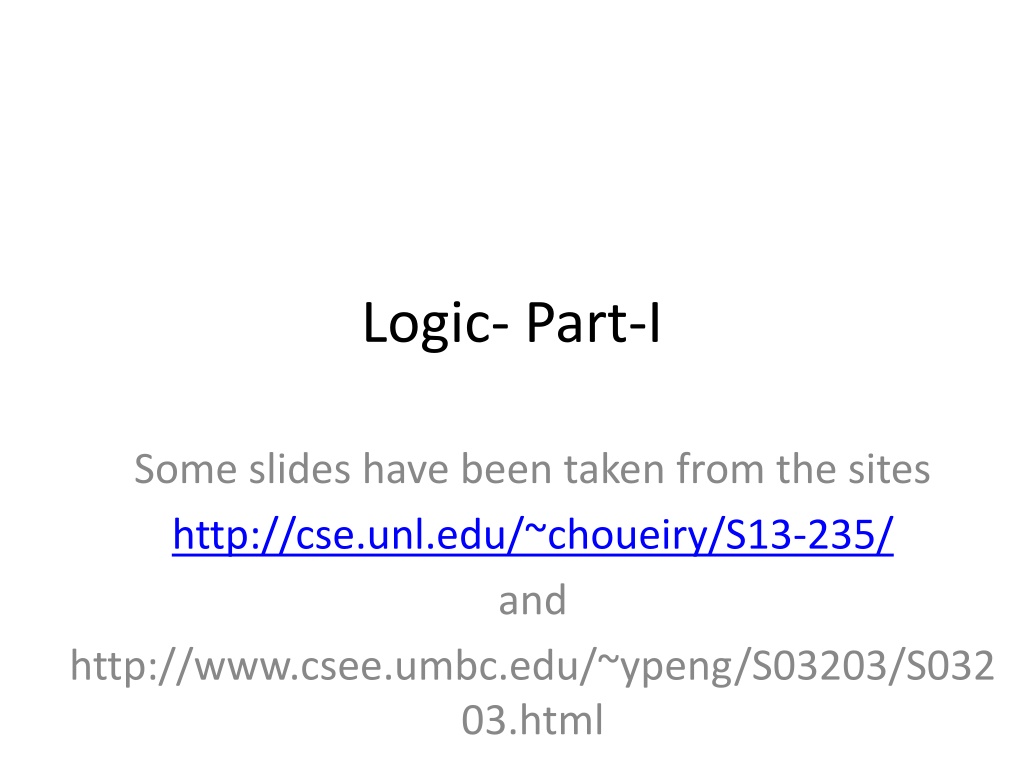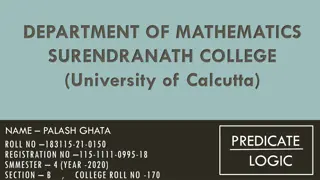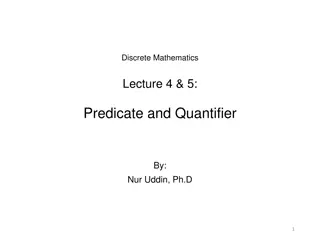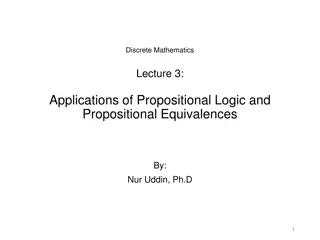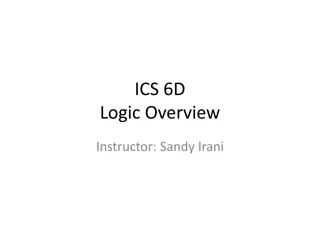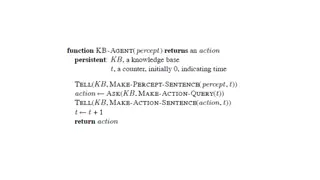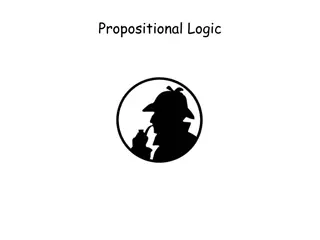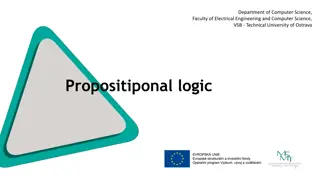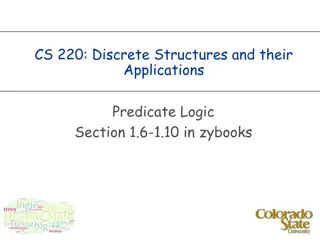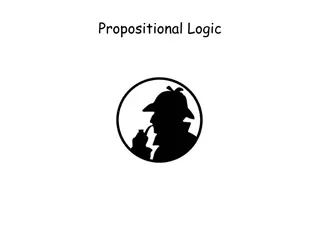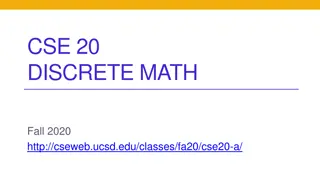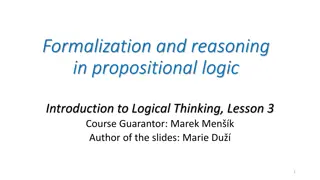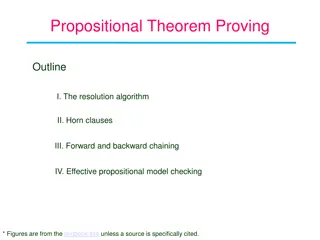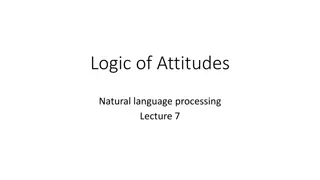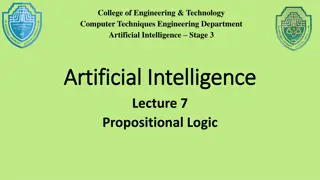Understanding Logic: An Introduction to Propositional Logic in Mathematics and Circuit Design
Logic plays a crucial role in mathematical reasoning, program design, and electronic circuitry. It is based on statements, known as propositions, that can be either true or false. A statement is a declarative sentence with a definitive truth value. Through examples, we explore the concept of statements and truth values, distinguishing between statements and open statements in logic.
Download Presentation

Please find below an Image/Link to download the presentation.
The content on the website is provided AS IS for your information and personal use only. It may not be sold, licensed, or shared on other websites without obtaining consent from the author. Download presentation by click this link. If you encounter any issues during the download, it is possible that the publisher has removed the file from their server.
E N D
Presentation Transcript
Logic- Part-I Some slides have been taken from the sites http://cse.unl.edu/~choueiry/S13-235/ and http://www.csee.umbc.edu/~ypeng/S03203/S032 03.html
Logic Important for mathematical reasoning, program design. Used for designing electronic circuitry (Propositional ) Logic is a system based on statements (also called propositions).
Logic A statement is a (declarative) sentence that is either true or false (not both). We say that the truth value of a proposition is either true (T) or false (F). Corresponds to 1 and 0 in digital circuits We usually denote a proposition by a letter: p, q, r, s,
Consider a sentence: The sun rises in the east Is it a statement? What is the truth value of the proposition?
Consider a sentence: The sun rises in the east Is it a statement? YES What is the truth value of the proposition? TRUE 5
Consider a sentence: {0,2,3} N = Is it a statement? What is the truth value of the proposition?
Consider a sentence: {0,2,3} N = Is it a statement? YES What is the truth value of the proposition? False
Consider a sentence: y > 21 Is it a statement? What is the truth value of the proposition?
Consider a sentence: y > 21 Is it a statement? No What is the truth value of the proposition? Its truth value depends on unspecified y. This statement is called an open statement.
Consider a sentence: Please do not fall asleep. Is it a statement? What is the truth value of the proposition?
Consider a sentence: Please do not fall asleep. Is it a statement? No What is the truth value of the proposition? It is neither true nor false.
Sentences that are not statements with similar expressions that are statements
Consider a sentence: Every even integer greater than 2 is a sum of two prime numbers. Goldbach conjecture Is it a statement? What is the truth value of the proposition?
Consider a sentence: Every even integer greater than 2 is a sum of two prime numbers. Goldbach conjecture Is it a statement? Yes What is the truth value of the proposition? Probably true
Consider a sentence: Either x is a multiple of 7 or it is not Is it a statement? What is the truth value of the proposition?
Consider a sentence: Either x is a multiple of 7 or it is not Is it a statement? Yes What is the truth value of the proposition? True since it is true for all x.
Logical Connectives (Operators) Combining statements to make compound statements. p, q, r, s, represent statements/propositions. Following connectives are considered now.
Logical Connective: Logical And The logical connective AND is true only when both of the propositions are true. It is also called a conjunction Examples It is raining and it is warm (2+3=5) and (1<2). Truth table
Logical Connective: Logical OR The logical disjunction, or logical OR, is true if one or both of the propositions are true. Examples It is raining or it is the second lecture (2+2=5) (1<2) Truth table
Logical Connective: Negation p, the negation of a proposition p, is also a proposition p: Today is Monday Examples: Today is not Monday It is not the case that today is Monday, etc. Truth table
Logical Connective: Exclusive Or The exclusive OR, or XOR, of two propositions is true when exactly one of the propositions is true and the other one is false Example The circuit is either ON or OFF but not both Let ab<0, then either a<0 or b<0 but not both Truth table
Logical Connective: Implication (1) Definition: Let p and q be two propositions. The implication p q is the proposition that is false when p is true and q is false and true otherwise p is called the hypothesis, antecedent, premise q is called the conclusion, consequence Truth table
Logical Connective: Implication (2) The implication of p q can be also read as p implies q If p, then q whenever p, then also q q follows from p p only if q (p cannot be true if q is not true) p is a sufficient condition for q (p is sufficient for q) q is a necessary condition for p (q is necessary for p)(p cannot be true unless q is true (i.e. if q is false, p is false)
Logical Connective: Implication () Consider the statements: you pass the exam you pass the course Equivalent statements: Passing the exam is sufficient for passing the course. For you to pass this course, it is sufficient that you pass the exam.
Exercise: Which of the following implications is true? If -1 is a positive number, then 2+2=5
Exercise: Which of the following implications is true? If -1 is a positive number, then 2+2=5 True. The premise is obviously false, thus no matter what the conclusion is, the implication holds.
Exercise: Which of the following implications is true? If -1 is a positive number, then 2+2=5 True. The premise is obviously false, thus no matter what the conclusion is, the implication holds. If -1 is a positive number, then 2+2=4 True. Same as above.
Exercise: Which of the following implications is true? If -1 is a positive number, then 2+2=5 True. The premise is obviously false, thus no matter what the conclusion is, the implication holds. If -1 is a positive number, then 2+2=4 True. Same as above. If you get an 100% on your Midterm 1, then you will have an A+.
Exercise: Which of the following implications is true? If -1 is a positive number, then 2+2=5 True. The premise is obviously false, thus no matter what the conclusion is, the implication holds. If -1 is a positive number, then 2+2=4 True. Same as above. If you get an 100% on your Midterm 1, then you will have an A+. False. Your grades homework, quizzes, Midterm 2, and Final, if they are bad, would prevent you from having an A+.
Exercises To take discrete mathematics, you must have taken calculus or a course in computer science. When you buy a new car from Acme Motor Company, you get $2000 back in cash or a 2% car loan. School is closed if more than 2 feet of snow falls and if the wind chill is below -80.
Exercises To take discrete mathematics, you must have taken calculus or a course in computer science. Propositions - p: take discrete math - q: you have taken calculus - r : you have taken a course in CS
Exercises When you buy a new car from Acme Motor Company, you get $2000 back in cash or a 2% car loan. Propositions - p: you buy a car - q: you you get $2000 back - r : you get 2% car loan
Exercises School is closed if more than 2 feet of snow falls and if the wind chill is below -80. Propositions - p: School is closed - q: 2 feet of snow falls - r : wind chill is below -80
Logical Connective: Biconditional (1) Definition: The biconditional proposition that is true when p and q have the same truth values. It is false otherwise. Note that it is equivalent to Truth table is the
Logical Connective: Biconditional (2) The biconditional p q can be equivalently read as p if and only if q p is a necessary and sufficient condition for q if p then q, and conversely p iff q Examples x>0 if and only if x2 is positive The alarm goes off iff a burglar breaks in
Truth Tables Truth tables are used to show/define the relationships between the truth values of the individual propositions and the compound propositions based on them
Precedence of Logical Operators As in arithmetic, an ordering is imposed on the use of logical operators in compound propositions However, it is preferable to use parentheses to disambiguate operators and facilitate readability p q r ( p) (q ( r)) To avoid unnecessary parenthesis, the following precedence hold:
Examples Sentence ? Some sets are finite. N PowerSet (N) Express each statement or open statement in one of the forms: p q, p q, or p. Today is cold but it is not cloudy x A B At least one of the numbers x and y equals 0.
Examples Express the following sentence in the form If P, then Q. We will order pizza today if there are 100 students in the class. (If there are 100 students, then we will order pizza today) We will order pizza today only if there are 100 students in the class. (If we order pizza today, there are 100 students in the class) You can use the lab if you are a cs major or not a freshman. (if you are a cs major or not a freshman, then you can use the lab.) An integer is divisible by 8 only if it is divisible by 4. (If an integer is divisible by 8, then it is divisible by 4.)
Logical Equivalence Two statements are logically equivalent if their truth values match up line-for-line in a truth table. Logical equivalence gives us different ways of looking at the same thing. Consider the following truth table concerning p q.
Example If m is an even integer then m+7 is odd. Let p: m is an even integer; q: m+7 is odd. Using propositional notation p q. Proving p q. p is true m=2a, a Z 2a + 6 is an even number (2a +6) +1 is an odd number m + 7 is an odd number q
Example Proving q p. q is not true m+7 is even m + 7 = 2b, b Z 2b 7 = 2(b-4) +1 2b 7 is odd m is odd p
Tautology A compound proposition (a formula) that is always true no matter what the truth values of the propositions in the formula is called a tautology. p p is a simple tautology. p q and q p are logically equivalent i.e. (p q) ( q p) is a tautology. (Truth table will be shown in the class)
Tautology A compound proposition (a formula) that is always true no matter what the truth values of the propositions in the formula is called a tautology. Informally, two compound propositions P and Q are logically equivalent if whenever P is true, Q is true, and whenever Q is true then P is true. In other words P Q is a tautology It is denoted as P = Q (in the text) Also denoted as P Q (Rosen); P Q (Grimaldi)
Contradiction A compound proposition (a formula) that is always false no matter what the truth values of the propositions in the formula is called a contradiction. p p is a simple contradiction.
The following table contains some important equivalences
The following table contains some important equivalences (contd.)
Some equivalences involving conditional statements
Example if ((x > 0) and (y > 0)) then writeln( ) is equivalent to if (x > 0) then if (y > 0) then writeln (---) Propositions (x and y are constants) p : x > 0 q : y > 0 r : line gets written Claim is (p q r) = (p (q r))
